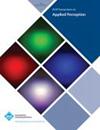虚拟环境中立体基地对盲区和视区的影响
IF 1.9
4区 计算机科学
Q3 COMPUTER SCIENCE, SOFTWARE ENGINEERING
引用次数: 14
摘要
在虚拟环境中,感知到的距离通常比预期的要短。在立体虚拟环境中,空间感知的一个重要参数是立体基础,即两个观看摄像机之间的距离。我们系统地改变立体基础相对于瞳距(IPD),并检查对距离和大小感知的影响。此外,我们测试了通过对准任务单独调整立体基座是否会减少距离估计的误差。参与者在闭上眼睛(盲手)或睁开眼睛(有视力的手)的情况下,对一个虚拟网球进行伸手动作。使用参与者的个人IPD,立体基础被设置为(a) IPD, (b)按比例较小,(c)按比例较大,或(d)根据事先进行的对准任务中的个人表现进行调整。总的来说,与之前的研究一致,距离被低估了。正如预期的那样,在较小的立体基座上,虚拟物体被认为更远、更大,而在较大的立体基座上,虚拟物体被认为更近、更小。然而,立体基底的操作对盲达估计的影响程度比预期的要小,这可能是由于双眼视差和图像深度线索的结合。在视觉反馈可用的情况下,视差匹配的使用可能会产生更大的立体基础效果。使用单独调整的立体基础减少了平均低估,但没有减少个体间方差。个体间差异是任务特异性的,不能通过立体视敏度或注视差异来解释。本文章由计算机程序翻译,如有差异,请以英文原文为准。
The Influence of the Stereo Base on Blind and Sighted Reaches in a Virtual Environment
In virtual environments, perceived distances are frequently reported to be shorter than intended. One important parameter for spatial perception in a stereoscopic virtual environment is the stereo base—that is, the distance between the two viewing cameras. We systematically varied the stereo base relative to the interpupillary distance (IPD) and examined influences on distance and size perception. Furthermore, we tested whether an individual adjustment of the stereo base through an alignment task would reduce the errors in distance estimation. Participants performed reaching movements toward a virtual tennis ball either with closed eyes (blind reaches) or open eyes (sighted reaches). Using the participants' individual IPD, the stereo base was set to (a) the IPD, (b) proportionally smaller, (c) proportionally larger, or (d) adjusted according to the individual performance in an alignment task that was conducted beforehand. Overall, consistent with previous research, distances were underestimated. As expected, with a smaller stereo base, the virtual object was perceived as being farther away and bigger, in contrast to a larger stereo base, where the virtual object was perceived to be nearer and smaller. However, the manipulation of the stereo base influenced blind reaching estimates to a smaller extent than expected, which might be due to a combination of binocular disparity and pictorial depth cues. In sighted reaching, when visual feedback was available, presumably the use of disparity matching led to a larger effect of the stereo base. The use of an individually adjusted stereo base diminished the average underestimation but did not reduce interindividual variance. Interindividual differences were task specific and could not be explained through differences in stereo acuity or fixation disparity.
求助全文
通过发布文献求助,成功后即可免费获取论文全文。
去求助
来源期刊

ACM Transactions on Applied Perception
工程技术-计算机:软件工程
CiteScore
3.70
自引率
0.00%
发文量
22
审稿时长
12 months
期刊介绍:
ACM Transactions on Applied Perception (TAP) aims to strengthen the synergy between computer science and psychology/perception by publishing top quality papers that help to unify research in these fields.
The journal publishes inter-disciplinary research of significant and lasting value in any topic area that spans both Computer Science and Perceptual Psychology. All papers must incorporate both perceptual and computer science components.
 求助内容:
求助内容: 应助结果提醒方式:
应助结果提醒方式:


